Article from: www.thenewspaper.com/news/45/4527.asp
10/8/2014
Dayton, Ohio Red Light Cameras Exploit Short Yellows
Dayton, Ohio violates a 2008 state law requiring one full second of extra yellow at red light camera intersections.
 Dayton, Ohio's red light cameras have generated more than $8 million over the past two years. Many of the $85 automated tickets are issued at intersections where the yellow signal warning times fall short of the minimum allowed under state law.
Dayton, Ohio's red light cameras have generated more than $8 million over the past two years. Many of the $85 automated tickets are issued at intersections where the yellow signal warning times fall short of the minimum allowed under state law.
In 2008, Governor Ted Strickland (D) signed House Bill 30 into law, requiring yellow times to be one second longer at any intersection where a red light camera was installed. Lawmakers were following the lead of Georgia which had adopted the first of its kind longer yellow law a month earlier. A few cities, including Atlanta, were caught attempting to ignore Georgia's then-new law, which produced an 80 percent reduction in violations in compliant cities.
Ohio's signal timing statute requires photo enforced intersections to have yellow durations one second longer than "similar" intersections in the city. Since the minimum yellow timing under federal regulations is 3.0 seconds, any time shorter than 4.0 seconds is automatically in violation of the law. Cities were given until March 12, 2009 to comply with the directive. Dayton has failed to do so.
According to documents provided by the city, the yellow time at the intersection of West Third Street and James H. McGee Boulevard is 4.6 seconds -- only a 0.6 increase from the amount of warning time given before 2008. The left turn signal, however, is below the 4.0 second minimum at just 3.5 seconds. The signal timings are identical at North Main Street and Hillcrest Avenue; Salem Avenue and North Avenue; and Troy Street and Stanley Avenue (with Troy Street kept shortened to 4.0 seconds). State law is explicit in requiring longer yellows in turn lanes.
"A local authority that uses traffic law photo-monitoring devices to enforce any traffic law at an intersection where traffic is controlled by traffic control signals that exhibit different colored lights or colored lighted arrows shall time the operation of the yellow lights and yellow arrows of those traffic control signals so that the steady yellow indication exceeds by one second the minimum duration for yellow indicators at similar intersections as established by the provisions of the manual adopted by the department of transportation under section 4511.09 of the Revised Code," Ohio Revised Code 4511.094 states.
In a review of signal timing throughout the state, most other cities applied the same duration of yellow to the straight-through lanes and the turning lanes. Dayton may also be in violation for failing to add a full second at intersections compared to the yellow durations before the law took effect.
Each fraction of a second difference in yellow time can have a significant influence on the number of red light camera citations issued. The majority of straight-through red light "violations" happen when a driver misjudges the end of the yellow light by less than 0.25 seconds -- literally the blink of an eye (view Texas Transportation Institute (TTI) chart). In most cases, a yellow shortened by one second can increase the number of tickets issued by 110 percent, according to TTI (view report).
 Dayton, Ohio's red light cameras have generated more than $8 million over the past two years. Many of the $85 automated tickets are issued at intersections where the yellow signal warning times fall short of the minimum allowed under state law.
Dayton, Ohio's red light cameras have generated more than $8 million over the past two years. Many of the $85 automated tickets are issued at intersections where the yellow signal warning times fall short of the minimum allowed under state law.